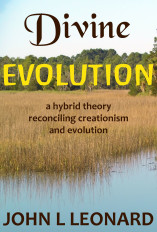 I love reading books written by Richard Dawkins. Quite ironically, he provides some of the very best material I could ever hope to find for use in discussions with my atheist friends about God and His creation, as well as existential science and evolution theory.
I love reading books written by Richard Dawkins. Quite ironically, he provides some of the very best material I could ever hope to find for use in discussions with my atheist friends about God and His creation, as well as existential science and evolution theory.
It turns out that virtually everything I might ever need for my argument in favor of a supernatural God can be found in his book The Greatest Show on Earth: the Evidence for Evolution, simply by following the advice of Dawkins and accepting many of his claims about the theory of evolution on face value.
For example, in his book Richard Dawkins claimed that humans share a now-extinct ancestor with the budgerigar (another name for the common parakeet) that lived approximately 310 million years ago, writing that “Every species is a cousin of every other. Any two species are descended from an ancestral species, which split in two.” (pg. 254)
That would mean every modern living organism must be directly related to every other living organism on earth by descent — with modifications, of course. Not only is your cousin a chimpanzee, but your slightly more distant cousin is allegedly the cucumber.
The most obvious question coming to mind about this idea would seem to be “how?”
Now my atheist friends have frequently suggested that I publish the evidence that http://frescohealth.com/shopping-cart/ disproves my cousinship to fruits and vegetables such as cucumbers and turnips so that I might earn fame, fortune, and even to win a Nobel Prize. However, the Nobel Prize does not honor a category for evolutionary biology, making the goal itself nonsensical, even if one assumes that the purpose of pursuing a career in science is to earn fame, fortune, and win the Nobel Prize.
Not even Charles Darwin would have won the Nobel Prize if the award had existed when he wrote On the Origin of Species. Ernst Mayr never won the Nobel Prize, and also noted that buy Pregabalin cheap uk there is no prize for evolutionary biology, presumably to silence his own critics. Besides, by the time I received my PhD in something, I’d only be a few years away from retirement age.
Furthermore, Richard Dawkins hasn’t won the Nobel Prize for Physiology and Medicine, either. So winning one can’t be that big of a deal.
Ideas matter. Book sales matter. Being able to defend one’s ideas with logic, reason, and the support of available scientific ideas matter. An honest pursuit of existential truth matters. Prizes and book awards, not so much.
Book sales matter. Being able to defend one’s ideas with logic, reason, and the support of available scientific ideas matter. An honest pursuit of existential truth matters. Prizes and book awards, not so much.
In case awards matter to other people and increase book sales, though, I will point out to the reader that the book shown on the right won a gold medal in an international book awards contest, as did collection of animal rescue short stories and the detective novel shown below.
Thus ends my brief foray into shameless self-promotion, which I freely admit only doing to irritate those critics of mine who often accuse me of relentless self promotion and trying to sell them a book that I’ve offered to give away.
This mentality reminds me of the classic line from Joseph Bologna in the movie Blame It on Rio: “Who packs, not to leave?”
 Who writes a book and manages to get published, but doesn’t want people to buy it?
Who writes a book and manages to get published, but doesn’t want people to buy it?
Not that I’m complaining, but I think my accountant might still tell me today that Mick Jagger, Keith Richard, and Bob Dylan have all made more money off copyright permissions from Divine Evolution, my first book, that I have earned from sales to date. Writing is a labor of love that will eventually pay financial dividends to my estate, if not before.
Buy a book and read — it doesn’t have to be one of mine. Broaden your horizons. Try to learn something new. End of commercial.
Now back on point…
It has been frequently said that extraordinary claims require extraordinary evidence. The assertion that humans might be related even to parakeets and even plants by sex, isolation of genetics, and time certainly would qualify as an extraordinary claim.
Dawkins writes (about the alleged reptilian human/parakeet common ancestor),
“In the unlikely event that a fossil of this ancestral species was ever found, it would need a name. Let’s call it Protamnio darwinii. We don’t know any details about it, and the details don’t matter [emphasis added] at all for the argument, but we won’t go far wrong if we imagine a sprawling lizard-like creature, scurrying about catching insects. Now, here’s the point. When Protamnio darwinii split into two sub-populations, they would have looked just the same as each other, and could have happily interbred with each other; but one lot were destined to give rise to the mammals, and the other lot were destined to give rise to the birds (and dinosaurs and snakes and crocodiles).” (pg. 254-5)
Now in order to reach this allegedly indisputable conclusion that humans and parakeets have ancestors in common, we only need to look at the evidence, according to Mr. Dawkins.
This is excellent advice, in my opinion. Never forget that extraordinary claims always require extraordinary evidence. So what exactly is this evidence, and what does it tell us?
Forgive me for stating the obvious, but birds have beaks, wings, and feathers. Their bones are hollow, yet incredibly strong. Birds lay eggs. Most birds can fly. They have a specially-adapted digestive system. In other words, birds are very, very different than human beings that appear to be engineered specifically for the capability of flight.
Neither birds nor humans are closely related to insect-eating lizards, though. Sure, birds, lizards, and humans have central nervous systems and cardio-vascular systems as well as skeletons, hearts, brains, eyes, and other organs that may be found in virtually every living animal, but this hardly qualifies as evidence for being the product of common descent.
Furthermore, Richard Dawkins admits that there is an “overwhelming illusion” of design we may observe in nature, but then dismisses even the possibility of design versus descent because of his personal bias towards atheism. To justify his assumption, he refers to alleged evidence of “bad” design like the routing of the vas deferens through the human body or the laryngeal nerve in giraffes. My dogs are theoretically not only my best friends, they are allegedly my cousins as well.
Does anyone else (besides me, of course) have a problem with the absence of logic being shown here? We are being asked — no, told to believe that humans are related to giraffes and parakeets through common ancestry, conditioned to believe that evolution theory is the only conceivable explanation for the existence of a human being.
We are told to basically ignore all the differences like feathers and wings and emphasize any perceived similarities. If we attempt to ask intelligent questions about the science, we are branded as evolution deniers, as if we know some great existential truth that we stubbornly refuse to admit.
Skepticism about science will not be tolerated. Only skepticism about religion is allowed.
Nevertheless, common ancestry means that the primary factors that cause such incredible diversity are sexual reproduction, isolation of the gene pool (usually due to geography), and time. Both Dawkins and Coyne clearly agree on the importance of those three factors, especially isolation, in the formation of new species. Quite frankly, we are being conditioned to believe that only descent can possibly explain how a lizard, a parakeet, and a human being are allegedly “related” to each other.
Dawkins insists that we should go and look at the evidence — perhaps he should take his own advice and speak with paleontologist Michael Benton. An excellent candidate for Protamnio darwinii might well be a dicynodont named Lystrosaurus, the primary terrestrial animal that survived the Permian extinction of about 250 million years ago, according to Professor Benton. What’s sixty million years in the Big Scheme of things, compared to the life span of a human being?
More time than we have to observe the alleged processes in action, that’s for sure. That is roughly the same amount of geologic time that has elapsed since the Cretaceous extinction killed off the dinosaurs. Most modern animal species we can observe today allegedly “evolved” within the last 65 million years, with a few notable exceptions such as crocodiles and coelacanths.
It would be absurd to deny the possibility that descent alone might explain the existence of both the ant and the anteater, the cotton plant and the boll weevil, because we know that species (or kinds) are perpetuated by sexual reproduction, which is of course, descent. But why should we assume descent must be the only possible contributing factor, when there is overwhelming evidence drawn from inference that suggests manipulation and design might also be involved?
My point is merely this: it is absolutely silly to assume that descent explains the relationship of humans to bananas, while details of the process by which it occurred remain completely unknown. My goal is not to persuade the reader he or she should not believe Darwin’s theory solves all problems — I’m asking for someone to explain how it works to me, so that I might believe, too.
Currently we don’t even seem to know how recent evolution occurred, for example how humans evolved from ape ancestors. The “smoking gun” evidence that advocates of evolution theory love to cite is the commonly believed fusion of human chromosome 2, which biologist Ken Miller has said appears to be so clear that it appears “something” joined two primate chromosomes together as clearly as if a piece of Scotch tape had been used to connect them.
However, when pressed to explain how a fused joining of those chromosomes could occur slowly over many generations, Professor Miller explained that the joining of those two chromosomes had no discernible impact on ape-to-human evolution. But how can an event with no known relationship to human evolution be claimed to provide evidence that it occurred? If the evidence that humans evolved from apes doesn’t explain how it happened, why should we believe that it even happened?
And if human chromosome 2 created by fusion didn’t cause ape-to-human evolution to occur, what did?
It’s very important to note that Richard Dawkins admits that we don’t have the slighted clue about what causes or allows macro evolution to occur, writing: “What actually happened at this epic parting of the ways (divergence from reptiles into species that evolve into both humans and parakeets), nobody knows.” (pg 255) How…inconvenient. Or convenient, depending on your point of view.
Doesn’t that seem like something vitally important to know before it becomes universally accepted to be an indisputable truth? How can we assume something could have only happened one way, if we don’t even have the slightest clue how that way actually works in the real world?
Remember, if evolution as Dawkins describes it really is true, you’re not only a cousin of a chimpanzee, you’re also literally the cousin of a cucumber. All dramatic (and beneficial) mutations only made possible by sex. Plus isolation of two gene pools from the same ancestral creature. And lots and lots of time, of course. Dawkins also wrote in his book that “Biologists use the word ‘speciation’ for the splitting of a species into two daughter species.”
The problem with what biologists call “speciation” is the definition of the word species, originally redefined by Ernst Mayr to mean animals that don’t reproduce for whatever reason, regardless of their kind. Doesn’t this sort of diminish the whole concept of selection? In ring species, is it true that the animals can’t reproduce, or could it be possible they don’t mate by choice? Is a bluebird absolutely unable to mate with a cardinal, or possibly just not attracted to them?
I don’t ask questions because I know all the answers…I’d only like to know them.
According to Dawkins, the cichlids of Lake Victoria have allegedly evolved into hundreds of new species of cichlids. But the cichlids haven’t actually become a truly new kind of organism. Only more diversity in cichlids can be observed, even 400,000 years after the lake formed.
The real question of speciation is this: how long does it take for tilapia to evolve into trout? Remember that in open ocean waters, a decent fisherman might catch bass, trout, flounder, salmon, mackerel, or they might encounter countless other forms of marine life — or perhaps they might even hook an alleged fossil fish, the coelacanth. Will the cichlids of Lake Victoria ever evolve into something other than a cichlid?
During Richard Lenski’s experiments with e-coli bacteria didn’t evolve into a completely different organism with a new body plan. It didn’t even evolve into a different form of bacteria such as salmonella or listeria. The e-coli merely adapted to changes in its environment. The experiments do demonstrate the remarkable resilience and ability to adapt to a changing environment for a well defined kind of animal, but haven’t shown how truly new organisms emerge.
My atheist friends want to know how I can dismiss evidence of evolution seen in ERVs, meaning the endogenous retroviruses that may become part of the DNA inherited by offspring.
Under what circumstances might an infection from a virus have beneficial results to the host organism? Trying to think of candidates for viruses that may become permanently embedded in the host’s DNA, I’m only coming up with examples such as herpes simplex/Chickenpox thus far — viruses without beneficial effect on the host organism.
New information might get added to the genome, all right, but it’s more than likely detrimental in nature, if it’s viral.
The latest and greatest discovery in evolutionary biology is the identification of the miR-941 gene that allegedly “helps to explain how humans evolved from apes. It appears to have played a crucial role in the development of the human brain and may shed light on our use of tools and language.”
The problem is that the article making this stunning announcement also had this to say:
Scientists say, however, that this gene emerged, in a startlingly brief interval of evolutionary time, fully functional out of non-coding genetic material. This material has been termed “junk DNA.” [emphasis added] Previous to this study, it has been remarkably difficult to see this process in action.
In light of these new clams, perhaps calling Sir Fred Hoyle’s famous tornado-through-a-junkyard analogy a “fallacy” is the truly egregious logical error in this exercise. I just don’t believe that the traits which make humans special formed quickly and naturally came from AREs and junk DNA.
 In his book The Greatest Show on Earth, Dawkins repeatedly encouraged his readers to imagine being private detectives investigating a crime scene. As it just so happens, that is precisely what I do for a living — I write detective novels, published using the pen name Rocky Leonard.
In his book The Greatest Show on Earth, Dawkins repeatedly encouraged his readers to imagine being private detectives investigating a crime scene. As it just so happens, that is precisely what I do for a living — I write detective novels, published using the pen name Rocky Leonard.
So I’ve had to train my mind to imagine crimes and then to solve them.
It seems intuitively more obvious to me that God, not good luck, has monkeyed around with our DNA.
God doesn’t make junk. Complexity exists for a reason.
Perhaps the most telling comment of all from Dawkins was this: “Once again, I must stress, the details [emphasis original] of my little story are pure fiction [emphasis added].” (pg. 256)
He follows that up with: “Most biologists will tell you that geographical isolation is the normal prelude to speciation, although some, especially entomologists, may chime in with the reservation that sympatric speciation can also be important. Sympatric speciation, too, requires some kind of initial, incidental separation to get the ball rolling, but it is something other than geographic isolation.” (pg. 257)
Given the stated importance of genetic isolation of two breeding populations within species boundary, does this mean that humans, in the age of worldwide travel, can no longer evolve on earth?
That thought seems to beg yet another question: must humans colonize outer space in order to be able to evolve into new species? How else might two different human gene pools get isolated long enough to diverge, in this day and age?
I know this article turned out to be long, but I wanted to cover as much territory as possible and get all of the residual questions off my chest, but to be perfectly honest, I don’t see future books about evolution or religion.
I’ve pretty much said all that needed to be said, and what I wanted to say. Until the announcement of next great evolutionary breakthrough, that is.
Perhaps when they claim to have discovered how gene mir-942 helped turn monkeys into men.

“Forgive me for stating the obvious, but birds have beaks, wings, and feathers. Their bones are hollow, yet incredibly strong. Birds lay eggs. Most birds can fly.”
Here’s the first chink in your armor. Some can’t fly at all, and some swim.
“They have a specially-adapted digestive system.”
Yes, they do. Millions of years of evolution at work. Specially-adapted is an excellent term, because it demonstrates that they responded to their environment.
“In other words, birds are very, very different than human beings that appear to be engineered specifically for the capability of flight.”
How did you arrive at “engineered?” I don’t see any evidence of engineering, especially when you have already conceded adaptation.
“It seems intuitively more obvious to me that God, not good luck, has monkeyed around with our DNA.”
Solving a problem is not a function of intuition. It is a function of asking the right questions and following evidence.
You claim “God, not good luck.” What you are saying is “Magic, not a well-substantiated explanation of some aspect of the natural world that is acquired through the scientific method and repeatedly tested and confirmed, preferably using a written, pre-defined, protocol of observations and experiments” has monkeyed around with our DNA…
You are falling on the fallacy of ignorance in your statement. Luck has nothing to do with the issue. But you accept magic as an answer?